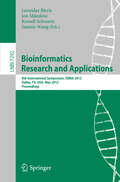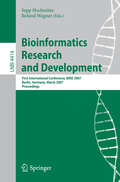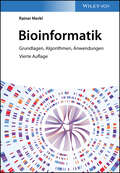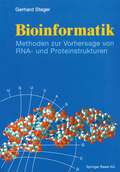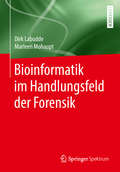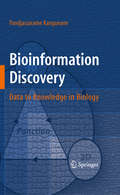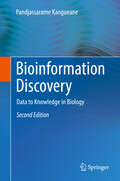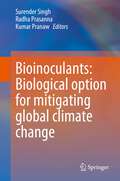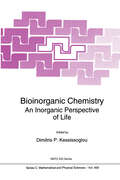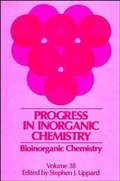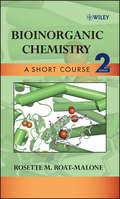- Table View
- List View
Bioinformatics Research and Applications: Fourth International Symposium, ISBRA 2008, Atlanta, GA, USA, May 6-9, 2008, Proceedings (Lecture Notes in Computer Science #4983)
by Ion Mandoiu Rajshekhar Sunderraman Alexander ZelikovskyThis book constitutes the refereed proceedings of the Fourth International Symposium on Bioinformatics Research and Applications, ISBRA 2008, held in Atlanta, GA, USA in May 2008. The 35 revised full papers presented together with 6 workshop papers and 6 invited papers were carefully reviewed and selected from a total of 94 submissions. The papers cover a wide range of topics, including clustering and classification, gene expression analysis, gene networks, genome analysis, motif finding, pathways, protein structure prediction, protein domain interactions, phylogenetics, and software tools.
Bioinformatics Research and Applications: Third International Symposium,ISBRA 2007, Atlanta, GA, USA, May 7-10, 2007, Proceedings (Lecture Notes in Computer Science #4463)
by Ion Mandoiu Alexander ZelikovskyThis book constitutes the refereed proceedings of the Third International Symposium on Bioinformatics Research and Applications, ISBRA 2007, held in Atlanta, GA, USA in May 2007. The 55 revised full papers presented together with three invited talks cover a wide range of topics, including clustering and classification, gene expression analysis, gene networks, genome analysis, motif finding, pathways, protein structure prediction, protein domain interactions, phylogenetics, and software tools.
Bioinformatics Research and Applications: 17th International Symposium, ISBRA 2021, Shenzhen, China, November 26–28, 2021, Proceedings (Lecture Notes in Computer Science #13064)
by Yanjie Wei Min Li Pavel Skums Zhipeng CaiThis book constitutes the proceedings of the 17th International Symposium on Bioinformatics Research and Applications, ISBRA 2021, held in Shenzhen, China, in November 2021. The 51 full papers presented in this book were carefully reviewed and selected from 135 submissions. They were organized in topical sections named: AI and disease; computational proteomics; biomedical imaging; drug screening and drug-drug interaction prediction; Biomedical data; sequencing data analysis.
Bioinformatics Research and Applications: 13th International Symposium, ISBRA 2017, Honolulu, HI, USA, May 29 – June 2, 2017, Proceedings (Lecture Notes in Computer Science #10330)
by Zhipeng Cai, Ovidiu Daescu and Min LiThis book constitutes the proceedings of the 13th International Symposium on Bioinformatics Research and Applications, ISBRA 2017, held in Honolulu, HI, USA, in May/June 2017. The 27 full papers presented together with 18 short papers and 24 invited abstracts were carefully reviewed and selected from 131 submissions. They cover topics such as: biomarker discovery; biomedical databases and data integration; biomedical text mining and ortologies; biomolecular imaging; comparative genomics; computational genetic epidemiology; computational proteomics; data mining and visualization; gene expression analysis; genome analysis; high-performance bio-computing; metagenomics; molecular evolution; molecular modelling and simulation; next-generation sequencing data analysis; pattern discovery and classification; population genetics; software tools and applications; structural biology; and systems biology.
Bioinformatics Research and Applications: 8th International Symposium, ISBRA 2012, Dallas, TX, USA, May 21-23, 2012. Proceedings (Lecture Notes in Computer Science #7292)
This book constitutes the refereed proceedings of the International Symposium on Bioinformatics Research and Applications, ISBRA 2012, held in Dallas, Texas, USA, in May 2012. The 26 revised full papers presented together with five invited talks were carefully reviewed and selected from 66 submissions. The papers address issues on various aspects of bioinformatics and computational biology and their applications.
Bioinformatics Research and Development: Second International Conference, BIRD 2008, Vienna, Austria, July 7-9, 2008 Proceedings (Communications in Computer and Information Science #13)
by Mourad Elloumi Josef Küng Michal Linial Robert Murphy Kristan Schneider Cristian TomaThis volume contains the papers which were selected for presentation at the second Bio- formatics Research and Development (BIRD) conference held in Vienna, Austria during July 7–9, 2008. BIRD covers a wide range of topics related to bioinformatics. This year sequence analysis and alignment, pathways, networks, systems biology, protein and RNA structure and function, gene expression/regulation and microarrays, databases and data integration, machine learning and data analysis were the subjects of main interest. The decisions of the Program Committee are based on the recommendations of at least three, up to five, reviews for each paper. As a result, 30 of the 61 submitted c- tributions could be accepted for the conference. We were happy to have three invited talks presented by experienced researchers providing visitors with a good overview but also some very important insights into the fascinating domain of bioinformatics. Abstracts and more information on these talks are provided in the conference program as well as at the conference site. In the second part of this volume the selected contributions of the two workshops which were held in parallel to the main conference are presented: Workshop on - namical Aspects of Perturbation, Intervention and Transition in Biological Systems – PETRIN 2008 and Workshop on Algorithms in Molecular Biology – ALBIO 2008 Poster presentations of the BIRD conference are in the companion proceedings published by the Trauner Verlag, Linz.
Bioinformatics Research and Development: First International Conference, BIRD 2007, Berlin, Germany, March 12-14, 2007, Proceedings (Lecture Notes in Computer Science #4414)
by Sepp Hochreiter Roland WagnerThis book constitutes the refereed proceedings of the First International Bioinformatics Research and Development Conference, BIRD 2007, held in Berlin, Germany in March 2007. The 36 revised full papers are organized in topical sections on microarray and systems biology and networks, medical, SNPs, genomics, systems biology, sequence analysis and coding, proteomics and structure, databases, Web and text analysis.
Bioinformatics - A Student's Companion
by Kalibulla Syed Ibrahim Guruswami Gurusubramanian Zothansanga Ravi Prakash Yadav Nachimuthu Senthil Kumar Shunmugiah Karutha Pandian Probodh Borah Surender MohanThis manual offers a stand-alone reading companion, unique in simplifying the practical components of Bioinformatics in a unique and user-friendly manner. It covers the practical component of syllabi used at most leading universities and discusses the most extensively used tools and methodologies in Bioinformatics. Research in the biological sciences has made tremendous strides in recent years due in part to the increased automation in data generation. At the same time, storing, managing and interpreting huge volumes of data has become one of the most challenging tasks for scientists. These two aspects have ultimately necessitated the application of computers, giving rise to a highly interdisciplinary discipline–Bioinformatics. Despite the richness of bioinformatics resources and methods, the exposure of life sciences undergraduates and postgraduates to bioinformatics is extremely limited. Though the internet offers various tools for free, and provides guides for using them, it fails to help users interpret the processed data. Moreover, most sites fail to update their help pages to accommodate software upgrades. Though the market is flooded with books discussing the theoretical concepts in Bioinformatics, a manual of this kind is rarely found. The content developed to meet the needs of readers from diverse background and to incorporate the syllabi of undergraduate and postgraduate courses at various universities.
Bioinformatics Techniques for Drug Discovery: Applications for Complex Diseases (SpringerBriefs in Computer Science)
by Aman Chandra Kaushik Ajay Kumar Shiv Bharadwaj Ravi Chaudhary Shakti SahiThe application of bioinformatics approaches in drug design involves an interdisciplinary array of sophisticated techniques and software tools to elucidate hidden or complex biological data. This work reviews the latest bioinformatics approaches used for drug discovery. The text covers ligand-based and structure-based approaches for computer-aided drug design, 3D pharmacophore modeling, molecular dynamics simulation, the thermodynamics of ligand−receptor and ligand−enzyme association, thermodynamic characterization and optimization, and techniques for computational genomics and proteomics.
Bioinformatics Technologies
by Yi-Ping Phoebe ChenSolving modern biological problems requires advanced computational methods. Bioinformatics evolved from the active interaction of two fast-developing disciplines, biology and information technology. The central issue of this emerging field is the transformation of often distributed and unstructured biological data into meaningful information. This book describes the application of well-established concepts and techniques from areas like data mining, machine learning, database technologies, and visualization techniques to problems like protein data analysis, genome analysis and sequence databases. Chen has collected contributions from leading researchers in each area. The chapters can be read independently, as each offers a complete overview of its specific area, or, combined, this monograph is a comprehensive treatment that will appeal to students, researchers, and R&D professionals in industry who need a state-of-the-art introduction into this challenging and exciting young field.
Bioinformatics With Python Cookbook: Use Modern Python Libraries And Applications To Solve Real-world Computational Biology Problems
by Tiago AntaoBioinformatik: Ein einführendes Lehrbuch
by Thomas Dandekar Meik KunzDieses Buch bietet eine packende Einführung in das am schnellsten wachsende Gebiet der Biologie mit leicht nachvollziehbaren Beispielen und einem gut aufbereitetem Anhang für den Leser, der so gleich alles direkt nachkochen und miterleben kann. Das Buch holt den Leser bei den Grundlagen ab, wie man zum Beispiel Sequenzinformationen einfach erhält und analysiert. In weiteren Kapiteln gehen die Autoren auf die verschiedenen Analysemöglichkeiten von RNA, DNA und Proteinen bis hinzu ganzen Stoffwechselwegen ein. Dabei werden in jedem Kapitel spannende Beispiele aus der Biologie gewählt, die zur Veranschaulichung der Analyse dienen. Jedes Kapitel wird mit einem Übungsteil abgeschlossen, welches das Gelernte sogleich zur Anwendung bringt. Das Thema dieses Buches ist ein Muss für jeden Biologiestudierenden, ob Bachelor- oder Masterstudium, da die Bioinformatik mittlerweile erstaunliche Einsichten in die molekularen Grundlagen aller Lebewesen zutage fördert.
Bioinformatik: Ein einführendes Lehrbuch
by Thomas Dandekar Meik KunzDieses Buch bietet eine packende Einführung in das am schnellsten wachsende Gebiet der Biologie mit leicht nachvollziehbaren Beispielen und einem gut aufbereiteten Anhang für die Leserschaft, um so gleich alles direkt nachkochen und miterleben zu können.Das Buch holt den Leser und die Leserin bei den Grundlagen ab, wie man zum Beispiel Sequenzinformationen einfach findet und dann analysiert. In weiteren Kapiteln gehen die Autoren auf die verschiedenen Analysemöglichkeiten von RNA, DNA und Proteinen bis hin zu ganzen Stoffwechselwegen ein. Dabei werden in jedem Kapitel spannende Beispiele aus der Biologie gewählt, die zur Veranschaulichung der Analyse dienen. Jedes Kapitel wird mit einem Übungsteil abgeschlossen, welches das Gelernte sogleich zur Anwendung bringt.Das Thema dieses Buches ist ein Muss für jeden Biologiestudierenden, ob Bachelor- oder Masterstudium, da die Bioinformatik mittlerweile erstaunliche Einsichten in die molekularen Grundlagen aller Lebewesen zutage fördert. Informatikstudierende und andere Studierende aus angrenzenden Naturwissenschaften bekommen einen guten Einstieg in die Bioinformatik, denn neben der Software werden systematisch die Biologie und aktuelle Themen (z.B. KI) Schritt für Schritt eingeführt.Entdecken Sie gemeinsam mit den Autoren den Schlüssel zum Leben und lernen Sie die Sprache des Lebens verstehen.
Bioinformatik: Ein Leitfaden für Naturwissenschaftler
by Andrea HansenWie berechnet man multiple Alignments? Wie nutzt man eine Datenbank, um die mühsam im Labor ermittelten Sequenzen effektiv zu analysieren? Und welche Datenbank ist überhaupt am besten geeignet? Locker und leicht verständlich geschrieben führt dieser Leitfaden in die Geheimnisse der Bioinformatik ein, ohne dass man als Naturwissenschaftler gleich Informatik im Nebenfach belegt haben muss. Schwerpunkt des Buches sind die Grundlagen und verschiedenen Möglichkeiten der Sequenzanalyse. Das Buch beginnt mit einer Einführung in die wichtigen Sequenzdatendatenbanken am NCBI und EMBL sowie in die wachsende Zahl der Motivdatenbanken. Anschließend werden die einfachsten Methoden des paarweisen Sequenzvergleiches in globalen und lokalen Alignments beschrieben sowie die gängigsten heuristischen Verfahren der Datenbanksuche (FASTA und BLAST). Multiple Alignments, Substitutionsmatrizen und die Berechnung phylogenetischer Bäume werden dem Leser nahe gebracht. Neu hinzugekommen sind auch Erläuterungen der Prinzipien der Genomanalyse und der gängigsten Algorithmen zur Genvorhersage. Zu jeder Methode werden Online-Tools im Internet oder freie Software angegeben. Der Leser wird so in die Lage versetzt, die beschriebenen Methoden selbstständig nachzuvollziehen. Die Autorin selbst ist Molekularbiologin und in der Bioinformatik-Branche tätig. Als ehemalige Betreuerin eines Bioinformatik-Kurses weiss sie aus eigener Erfahrung, auf welche Informationen es ankommt, um schnell und zielorientiert zu den gewünschten Ergebnissen zu gelangen. Das Buch richtet sich in erster Linie an Anwender und Einsteiger in die Bioinformatik. Angesprochen sind vor allem Studenten und Forscher aus allen Gebieten der Naturwissenschaften, die sich in Studium oder Beruf mit der Sequenzanalyse auseinandersetzen müssen. Gleichzeitig ist dieses Buch auch ein Leitfaden für all diejenigen, die die aufgeführten Methoden zwar regelmässig benutzen, aber noch nie die Zeit gefunden haben, sich mit den Grundlagen auseinanderzusetzen.
Bioinformatik: Ein Leitfaden für Naturwissenschaftler
by Andrea HansenWie berechnet man multiple Alignments? Wie nutzt man eine Datenbank, um die mühsam im Labor ermittelten Sequenzen effektiv zu analysieren? Und welche Datenbank ist überhaupt am besten geeignet? Locker und leicht verständlich geschrieben führt dieser Leitfaden in die Geheimnisse der Bioinformatik ein, ohne dass man als Naturwissenschaftler gleich Informatik im Nebenfach belegt haben muss. Schwerpunkt des Buches sind die Grundlagen und verschiedenen Möglichkeiten der Sequenzanalyse. Das Buch beginnt mit einer Einführung in die wichtigen Sequenzdatendatenbanken am NCBI und EMBL sowie in die wachsende Zahl der Motivdatenbanken. Anschließend werden die einfachsten Methoden des paarweisen Sequenzvergleiches in globalen und lokalen Alignments beschrieben sowie die gängigsten heuristischen Verfahren der Datenbanksuche (FASTA und BLAST). Multiple Alignments, Substitutionsmatrizen und die Berechnung phylogenetischer Bäume werden dem Leser nahe gebracht. Neu hinzugekommen sind auch Erläuterungen der Prinzipien der Genomanalyse und der gängigsten Algorithmen zur Genvorhersage. Zu jeder Methode werden Online-Tools im Internet oder freie Software angegeben. Der Leser wird so in die Lage versetzt, die beschriebenen Methoden selbstständig nachzuvollziehen. Die Autorin selbst ist Molekularbiologin und in der Bioinformatik-Branche tätig. Als ehemalige Betreuerin eines Bioinformatik-Kurses weiss sie aus eigener Erfahrung, auf welche Informationen es ankommt, um schnell und zielorientiert zu den gewünschten Ergebnissen zu gelangen. Das Buch richtet sich in erster Linie an Anwender und Einsteiger in die Bioinformatik. Angesprochen sind vor allem Studenten und Forscher aus allen Gebieten der Naturwissenschaften, die sich in Studium oder Beruf mit der Sequenzanalyse auseinandersetzen müssen. Gleichzeitig ist dieses Buch auch ein Leitfaden für all diejenigen, die die aufgeführten Methoden zwar regelmässig benutzen, aber noch nie die Zeit gefunden haben, sich mit den Grundlagen auseinanderzusetzen.
Bioinformatik: Grundlagen, Algorithmen, Anwendungen
by Rainer MerklBioinformatik Der Marktführer bei den Bioinformatiklehrbüchern in neuer Auflage und mit dem neuen Thema Molekulardynamik Bioinformatik ist eine Kerndisziplin in den modernen Biowssenschaften, von der Biotechnologie über die Biochemie und Molekularbiologie bis zur Molekulargenetik und Molekularmedizin. Sie ist eine essenzielle Grundlage für alle “omics”-Technologien, für die Strukturbiologie, die Systembiologie sowie die synthetische Biologie. Bioinformatik. Grundlagen, Algorithmen, Anwendungen bietet eine umfassende Einführung in die wichtigsten Methoden der Bioinformatik. Der Autor erklärt dabei sowohl die mathematischen und biologischen Grundlagen als auch die wichtigsten Software-Tools und deren Anwendungsbereiche. Schwerpunkte sind Methoden zum Sequenzvergleich, Verfahren zur Charakterisierung von Proteinfamilien, Algorithmen zur Vorhersage von Protein- und RNA-Strukturen, Methoden des maschinellen Lernens und das Proteindesign. Für die 4. Auflage wurde der Text durchgehend aktualisiert und um ein Kapitel zur Molekulardynamik erweitert. Neu aufgenommene Exkurse zu Meilensteinen der Bioinformatik und aktuellen Anwendungsgebieten lockern den Text auf. Auf der ebenfalls komplett überarbeiteten Begleit-Webseite werden interaktive Lernmodule bereitgestellt, einschließlich mehr als 120 Übungsaufgaben, zum Teil mit Lösungen. Eine perfekte Einführung für alle Studenten der Lebenswissenschaften oder Informatik, die einen Einblick in die gängigen Methoden der Bioinformatik benötigen, sowie ein wertvoller Begleiter für alle, die bereits bioinformatische Werkzeuge nutzen und die zugrundeliegenden Konzepte verstehen möchten.
Bioinformatik: Grundlagen, Algorithmen, Anwendungen
by Rainer MerklBioinformatik Der Marktführer bei den Bioinformatiklehrbüchern in neuer Auflage und mit dem neuen Thema Molekulardynamik Bioinformatik ist eine Kerndisziplin in den modernen Biowssenschaften, von der Biotechnologie über die Biochemie und Molekularbiologie bis zur Molekulargenetik und Molekularmedizin. Sie ist eine essenzielle Grundlage für alle “omics”-Technologien, für die Strukturbiologie, die Systembiologie sowie die synthetische Biologie. Bioinformatik. Grundlagen, Algorithmen, Anwendungen bietet eine umfassende Einführung in die wichtigsten Methoden der Bioinformatik. Der Autor erklärt dabei sowohl die mathematischen und biologischen Grundlagen als auch die wichtigsten Software-Tools und deren Anwendungsbereiche. Schwerpunkte sind Methoden zum Sequenzvergleich, Verfahren zur Charakterisierung von Proteinfamilien, Algorithmen zur Vorhersage von Protein- und RNA-Strukturen, Methoden des maschinellen Lernens und das Proteindesign. Für die 4. Auflage wurde der Text durchgehend aktualisiert und um ein Kapitel zur Molekulardynamik erweitert. Neu aufgenommene Exkurse zu Meilensteinen der Bioinformatik und aktuellen Anwendungsgebieten lockern den Text auf. Auf der ebenfalls komplett überarbeiteten Begleit-Webseite werden interaktive Lernmodule bereitgestellt, einschließlich mehr als 120 Übungsaufgaben, zum Teil mit Lösungen. Eine perfekte Einführung für alle Studenten der Lebenswissenschaften oder Informatik, die einen Einblick in die gängigen Methoden der Bioinformatik benötigen, sowie ein wertvoller Begleiter für alle, die bereits bioinformatische Werkzeuge nutzen und die zugrundeliegenden Konzepte verstehen möchten.
Bioinformatik: Methoden zur Vorhersage von RNA- und Proteinstrukturen
by Gerhard StegerMit Hilfe der Bioinformatik können ermittelte DNA-, RNA- oder Aminosäuresequenzen hinsichtlich Struktur und Funktion schnell eingeschätzt werden; das spart Kosten und Zeit bei weiterführenden Experimenten im Labor. Das vorliegende Buch gliedert sich in einen RNA- und einen Protein-Teil. Je ein Kapitel führt das biologische Thema der Strukturvorhersage inklusive biophysikalischer Grundlagen der Vorhersagemethoden ein. Folgekapitel gehen auf die informationstechnischen Methoden mit einem möglichst kurzen Beispiel ein, stellen den meist komplizierteren Algorithmus zur Lösung des biologischen Problems vor und diskutieren zum Abschluss mindestens eine Implementation und damit erzielbare Ergebnisse anhand eines biologischen Beispiels. Das Buch ist gleichermassen für Biologen und Informatiker relevant, da es sowohl einen Überblick über die aktuellen Möglichkeiten der Strukturvorhersage gibt als auch den Einsatz von unterschiedlichsten informationstechnischen Methoden in der Biologie demonstriert.
Bioinformatik im Handlungsfeld der Forensik
by Dirk Labudde Marleen MohauptDieses Lehrbuch soll Studierenden den Einstieg in die Gebiete der Forensik und Bioinformatik gleichermaßen erleichtern. Anhand eines fiktiven Falls, der sich durch das gesamte Buch zieht, wird die Bioinformatik und deren Grundlagen in das Gebiet der Forensik übertragen. Der Fall deckt eine Vielzahl an biologischen Spuren, sowie deren klassische Analyse ab und definiert neue Handlungsfelder in der Bioinformatik und Forensik.In diesem Werk werden verschiedenste Bereiche der Forensik bioinformatisch aufbereitet: Genetischer Fingerabdruck: Auswertung auf Sequenz- statt auf Profilebene Fingerspuren: krankheitsbedingte bzw. genetisch bedingte VeränderungenUntersuchungen zum Phänotyp einer PersonGrundlegende Erkenntnisse zur Wundheilung sowie zur Blutalterung in- und ex-vivo Dieses Buch zeigt die Notwendigkeit auf, die Forensik um weitere Wissensbereiche zu ergänzen und gibt Einblicke in eine Vielzahl moderner Themen der Forensik wie zum Beispiel Populationsgenetik; Wundaltersbestimmung, Daktyloskopie oder Menschen ohne Fingerabdruck.Vor allem Studierende aus den Lebenswissenschaften sowie Dozierende ebendieser Fachrichtung, werden durch dieses Lehrbuch spannende Einblicke in topaktuelle Fragestellungen bekommen.
Bioinformation Discovery: Data to Knowledge in Biology
by Pandjassarame KangueaneBioinformation Discovery illustrates the power of biological data in knowledge discovery. It describes biological data types and representations with examples for creating a workflow in Bioinformation discovery. The concepts in knowledge discovery from data are illustrated using line diagrams. The principles and concepts in knowledge discovery are used for the development of prediction models for simulations of biological reactions and events. Advanced topics in molecular evolution and cellular & molecular biology are addressed using Bioinformation gleaned through discovery. Each chapter contains approximately 10 exercises for practice. This will help students to expand their problem solving skills in Bioinformation Discovery. Each chapter concludes with a number of good problem sets to test mastery of the material.
Bioinformation Discovery: Data to Knowledge in Biology
by Pandjassarame KangueaneThis new edition continues to illustrate the power of biological data in knowledge discovery. It describes biological data types and representations with examples for creating a workflow in bioinformation discovery. The concepts in knowledge discovery from data are illustrated using line diagrams. The principles and concepts in knowledge discovery are used for the development of prediction models for simulations of biological reactions and events. Advanced topics in molecular evolution and cellular & molecular biology are addressed using bioinformation gleaned through discovery. Each chapter contains approximately 10 exercises for practice. This will help students to expand their problem solving skills in Bioinformation Discovery. In this new edition, there are three new chapters covering single nucleotide polymorphism, genes, proteins and disease, and protein functions driven by surface electrostatics.
Bioinoculants: Biological Option for Mitigating global Climate Change
by Surender Singh Radha Prasanna Kumar PranawThis edited book covers various bioinoculants for sustainable crop production under the changing global climate. The book envisages a compilation of articles relevant to the current status of production and use of novel microbial inoculants for different crops and highlights their role in mitigating global climate challenges. These include nutrient deficiencies, salinity, drought, and emerging pathogens. In addition, success stories and commercialization aspects are also discussed. Growing environmental concerns related to climate change can potentially decrease the global yield capacity of agricultural systems. Agricultural productivity is severely affected by major biotic and abiotic factors. The phytomicrobiome plays a critical role in the survival of the holobiont, particularly for plants growing in extreme environments. The use of microbial-based agricultural inputs has a long history, beginning with a broad-scale rhizobial inoculation of legumes in the early twentieth century. Microbial inoculants are considered one of the best and most effective strategies for sustainable agriculture under climate change, and a viable solution to meet the twin challenges of global food security and environmental sustainability. It is therefore imperative to understand the current status and development in the area of bioinoculants from a global perspective. The chapter’s focus would be on major agro-ecologies, covering all major crops across the globe, along with the commercialization status of different bioinoculants in different countries The book caters to the needs of the students, faculty, policymakers, and researchers working in the area of microbiology, biotechnology, environmental sciences, and botany.
Bioinorganic Chemistry: An Inorganic Perspective of Life (Nato Science Series C: #459)
by D. P. KessissoglouBioinorganic chemistry is primarily concerned with the role of metal atoms in biology and is a very active research field. However, even though such important structures of metalloenzymes are known, as the MoFeCo of nitrogenase, Cu or Mn superoxide dismutase and plastocyanin, the synthetic routes to the modelling of such centers remains a matter of acute scientific interest. Other metalloenzymes, such as the Mn center of the oxygen evolving complex of PSII, are still the focus of in-depth examination, both spectroscopic and structural. Another area of concern is the interaction between drugs and metals and metal ion antagonism. Understanding the chemistry of metal ions in biological systems will bring benefits in terms of understanding such problems as biomineralization and the production of advanced materials by micro-organisms. The 29 contributions to Bioinorganic Chemistry: An Inorganic Perspective of Life give an excellent summary of the state of the art in this field, covering areas from the NMR of paramagnetic molecules to the use of lanthanide porphyrins in artificial batteries.
Bioinorganic Chemistry (Progress in Inorganic Chemistry #76)
by Stephen J. LippardThis comprehensive series of volumes on inorganic chemistry provides inorganic chemists with a forum for critical, authoritative evaluations of advances in every area of the discipline. Every volume reports recent progress with a significant, up-to-date selection of papers by internationally recognized researchers, complemented by detailed discussions and complete documentation. Each volume features a complete subject index and the series includes a cumulative index as well.
Bioinorganic Chemistry: A Short Course
by Rosette M. Roat-MaloneAn updated, practical guide to bioinorganic chemistry Bioinorganic Chemistry: A Short Course, Second Edition provides the fundamentals of inorganic chemistry and biochemistry relevant to understanding bioinorganic topics. Rather than striving to provide a broad overview of the whole, rapidly expanding field, this resource provides essential background material, followed by detailed information on selected topics. The goal is to give readers the background, tools, and skills to research and study bioinorganic topics of special interest to them. This extensively updated premier reference and text: Presents review chapters on the essentials of inorganic chemistry and biochemistry Includes up-to-date information on instrumental and analytical techniques and computer-aided modeling and visualization programs Familiarizes readers with the primary literature sources and online resources Includes detailed coverage of Group 1 and 2 metal ions, concentrating on biological molecules that feature sodium, potassium, magnesium, and calcium ions Describes proteins and enzymes with iron-containing porphyrin ligand systems-myoglobin, hemoglobin, and the ubiquitous cytochrome metalloenzymes-and the non-heme, iron-containing proteins aconitase and methane monooxygenase Appropriate for one-semester bioinorganic chemistry courses for chemistry, biochemistry, and biology majors, this text is ideal for upper-level undergraduate and beginning graduate students. It is also a valuable reference for practitioners and researchers who need a general introduction to bioinorganic chemistry, as well as chemists who want an accessible desk reference.




